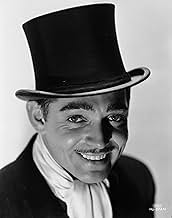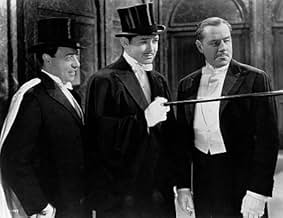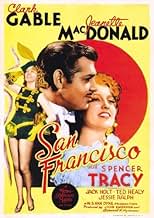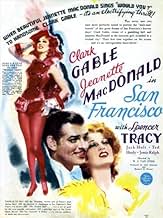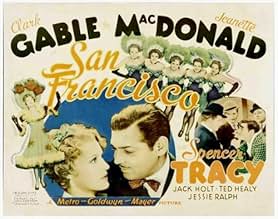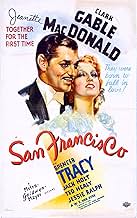San Francisco
- 1936
- Tous publics
- 1h 55min
NOTE IMDb
7,1/10
6,4 k
MA NOTE
Un homme de Barbary Coast et un impresario de Nob Hill sont rivaux pour les affections d'une belle chanteuse, à la fois personnellement et professionnellement en 1906 à San Francisco.Un homme de Barbary Coast et un impresario de Nob Hill sont rivaux pour les affections d'une belle chanteuse, à la fois personnellement et professionnellement en 1906 à San Francisco.Un homme de Barbary Coast et un impresario de Nob Hill sont rivaux pour les affections d'une belle chanteuse, à la fois personnellement et professionnellement en 1906 à San Francisco.
- Réalisation
- Scénario
- Casting principal
- Récompensé par 1 Oscar
- 5 victoires et 6 nominations au total
Charles Judels
- Tony
- (as Charles Judells)
Warren Hymer
- Hazeltine
- (as Warren B. Hymer)
Avis à la une
This is a great old film. I have seen it several times, and enjoy it every time. I think Jeanette MacDonald is beautiful, and what a voice! I love to hear her sing.
My mother gave me my middle name of Jeanette after her. It is interesting that a film with so much "fancy" singing
could have been so popular. The general public must have had more class then than now.
It is good to see the "oldies." Many of them are better than today's films.
I certainly like this one.
My mother gave me my middle name of Jeanette after her. It is interesting that a film with so much "fancy" singing
could have been so popular. The general public must have had more class then than now.
It is good to see the "oldies." Many of them are better than today's films.
I certainly like this one.
SAN FRANCISCO is a major Hollywood production from the 1930's, From the Boldness of the opening credits, along with a rousing rendition of the tune by the same name, the viewer suspects that they are going to witness a special movie event.
The plot is a rather forthright formula story of a tug-of-war romance between bad boy Clark Gable (Blackie Nortion, saloon owner) and mama's boy Jack Holt (Jack Burley, scion of a well-to -do family) for the affections of singer Jeanette MacDonald (Mary Blake, beautiful, virginal). It's also a story of good vs. evil, the good portrayed by Spencer Tracy as a Catholic Priest.
But it's the hard-hitting script and it's crisp dialogue, the recreation of a turn-of-the-Century San Francisco, the great acting, the music, and the fabulous Earthquake sequences that make this show the classic that it is.
SAN FRANCISCO is a tale of contrasts. On one hand the Barbary Coast with it's bars and bordellos, yet on the other hand we have a city of the fine arts, opera, and the Nob Hill elite. We have the rich, the spendthrifts, and also the poor who seek shelter in the Mission Houses.
The acting of Clark Gable cannot go unmentioned. His Blackie Norton is the most mockingly amoral character, proud of his lack of religious faith..... relying only on himself. Yet as Father Mullin (Tracy) says at one point in the movie, "Do you know who gave the chapel that organ we've been dedicating tonight? The most scoffing, unbelieving, and godless soul in all San Francisco, ..Blackie Norton. Cost him over $4,000......Don't tell him I told you. Blackie's like that, ashamed of his good deeds as most men are ashamed of their bad."
The famous 1906 Earthquake is a real show-stopper. Entire sets were hoisted on hydraulic lifts and rockers, and literally shaken down. VERY REALISTIC. I would have reservations about showing this picture to kids under 10 years of age. They may develop a neurotic fear of earthquakes following this one.
Enjoy and re-enjoy.
The plot is a rather forthright formula story of a tug-of-war romance between bad boy Clark Gable (Blackie Nortion, saloon owner) and mama's boy Jack Holt (Jack Burley, scion of a well-to -do family) for the affections of singer Jeanette MacDonald (Mary Blake, beautiful, virginal). It's also a story of good vs. evil, the good portrayed by Spencer Tracy as a Catholic Priest.
But it's the hard-hitting script and it's crisp dialogue, the recreation of a turn-of-the-Century San Francisco, the great acting, the music, and the fabulous Earthquake sequences that make this show the classic that it is.
SAN FRANCISCO is a tale of contrasts. On one hand the Barbary Coast with it's bars and bordellos, yet on the other hand we have a city of the fine arts, opera, and the Nob Hill elite. We have the rich, the spendthrifts, and also the poor who seek shelter in the Mission Houses.
The acting of Clark Gable cannot go unmentioned. His Blackie Norton is the most mockingly amoral character, proud of his lack of religious faith..... relying only on himself. Yet as Father Mullin (Tracy) says at one point in the movie, "Do you know who gave the chapel that organ we've been dedicating tonight? The most scoffing, unbelieving, and godless soul in all San Francisco, ..Blackie Norton. Cost him over $4,000......Don't tell him I told you. Blackie's like that, ashamed of his good deeds as most men are ashamed of their bad."
The famous 1906 Earthquake is a real show-stopper. Entire sets were hoisted on hydraulic lifts and rockers, and literally shaken down. VERY REALISTIC. I would have reservations about showing this picture to kids under 10 years of age. They may develop a neurotic fear of earthquakes following this one.
Enjoy and re-enjoy.
You can't go wrong with the pairing of two of the great stars of Hollywood, Gable and Tracy......and the great star of the west coast, San Francisco. The role of Blackie Norton may be one of Gable's best, so cynical,so devil-may-care and just a little bit dangerous. Tracy play the understanding priest with his usual aplomb. As he told someone once "Don't ever let them catch you acting".
Gable's attraction to Jeanette McDonald is a little bit unbelievable. She really did belong with Jack Holt in this film......or better yet Nelson Eddy should have showed up at the last minute and swept her away with a song. Gable and McDonald don't mesh at all and there was not much chemistry between them although I must admit she is lovely. Be that as it may, the film is one of the best of Hollywood's mid-30's offerings. There is something for everyone; music, drama, comedy and the finale of the earthquake which is what we are waiting for. And what a spectacle it is!! It is very well done in those days before sophisticated special effects; with tumbling buildings, crashing walls and the inevitable fire. There are a couple of poignant scenes when the firefighters must blow up buildings and homes to control the fire thus destroying lifetimes of work and memories.
The ending is a little bit over the top as those who have lost their families and all that they own, joyously sing the Battle Hymn of the Republic and march up the hill to view the destruction (I'm not sure I would be that upbeat)......but it is still effective. The fade to the modern day (1936) San Francisco is just the right ending note. I highly recommend this film, not only for the Gable/Tracy pairing but also for the general excellence of the production.
Gable's attraction to Jeanette McDonald is a little bit unbelievable. She really did belong with Jack Holt in this film......or better yet Nelson Eddy should have showed up at the last minute and swept her away with a song. Gable and McDonald don't mesh at all and there was not much chemistry between them although I must admit she is lovely. Be that as it may, the film is one of the best of Hollywood's mid-30's offerings. There is something for everyone; music, drama, comedy and the finale of the earthquake which is what we are waiting for. And what a spectacle it is!! It is very well done in those days before sophisticated special effects; with tumbling buildings, crashing walls and the inevitable fire. There are a couple of poignant scenes when the firefighters must blow up buildings and homes to control the fire thus destroying lifetimes of work and memories.
The ending is a little bit over the top as those who have lost their families and all that they own, joyously sing the Battle Hymn of the Republic and march up the hill to view the destruction (I'm not sure I would be that upbeat)......but it is still effective. The fade to the modern day (1936) San Francisco is just the right ending note. I highly recommend this film, not only for the Gable/Tracy pairing but also for the general excellence of the production.
As in the '70s, disaster films were all the rage in the '30s, with "Hurricane," "The Rains Came," "In Old Chicago," and, of course, 1936's "San Francisco" which certainly sent the other studios running to destroy anything they could. The film stars Clark Gable, Jeannette MacDonald, and Spencer Tracy as three citizens of that beautiful city on April 18, 1906, when the big earthquake struck.
Gable plays Blackie Norton, a quintessential role for him - a tough, charming rogue who runs The Paradise Club. MacDonald is the lovely and talented Mary Black who arrives there looking for work, and Spencer Tracy is Father Tim, who is Blackie's conscience (so he ignores him) and Mary's moral compass. Mary is torn between two loves - her love for Blackie and her love for opera. Burley (Jack Holt) wants her contract from Blackie so he can star her at the Tivoli Opera, but in all things, she suppresses her own desires so that she can stay with Blackie. She finally does leave but returns...only to leave again after an ugly confrontation between Blackie and Father Tim. Things get a lot uglier at an annual contest - and that's when the chandelier starts moving back and forth.
It's amazing what the films in the pre-computer age were able to do with special effects because the earthquake in "San Francisco" is dazzling, spectacular, and downright scary. Given the horrors of 9/11 and Katrina, one is drawn into the devastation and suffering as people search for loved ones, watch their houses fall, go crazy, and see their beloved city dynamited because there's no water to stop the raging fires. 70 years later, it's all way too close to home.
As good as he always was with Gable, Spencer Tracy did not have much of a role as the good father, but he's excellent. MacDonald poses a problem. Normally, she plays a diva or spitfire, and she did those roles beautifully. But Mary Blake is a modest and religious woman who speaks softly and sublimates her own desires for the man she loves. It doesn't ring true, and it doesn't work opposite the volatile Blackie of Gable's. If Mary had been more like other roles she played, MacDonald probably would have had good chemistry with him. As it is, they don't make much of a couple. Her singing is pretty until she hits the opera stage - with the combination of the tinny sound system in those days and the way women were trained on high notes then, the end result isn't good. She sings "The Jewel Song," which she often did in concert, the finale of "Faust," and "Sempre Libera." MacDonald was a lyric coloratura and suited to the demands of the opera stage in the '30s, but today she sounds dated as standards have changed.
This is a great film to see to appreciate the artistry of the early technicians. The effects in "San Francisco" hold up against anything that came 40 years later. The ending is pure Hollywood hokum, but very stirring. It gave this viewer goosebumps. Don't miss Hollywood at its very best.
Gable plays Blackie Norton, a quintessential role for him - a tough, charming rogue who runs The Paradise Club. MacDonald is the lovely and talented Mary Black who arrives there looking for work, and Spencer Tracy is Father Tim, who is Blackie's conscience (so he ignores him) and Mary's moral compass. Mary is torn between two loves - her love for Blackie and her love for opera. Burley (Jack Holt) wants her contract from Blackie so he can star her at the Tivoli Opera, but in all things, she suppresses her own desires so that she can stay with Blackie. She finally does leave but returns...only to leave again after an ugly confrontation between Blackie and Father Tim. Things get a lot uglier at an annual contest - and that's when the chandelier starts moving back and forth.
It's amazing what the films in the pre-computer age were able to do with special effects because the earthquake in "San Francisco" is dazzling, spectacular, and downright scary. Given the horrors of 9/11 and Katrina, one is drawn into the devastation and suffering as people search for loved ones, watch their houses fall, go crazy, and see their beloved city dynamited because there's no water to stop the raging fires. 70 years later, it's all way too close to home.
As good as he always was with Gable, Spencer Tracy did not have much of a role as the good father, but he's excellent. MacDonald poses a problem. Normally, she plays a diva or spitfire, and she did those roles beautifully. But Mary Blake is a modest and religious woman who speaks softly and sublimates her own desires for the man she loves. It doesn't ring true, and it doesn't work opposite the volatile Blackie of Gable's. If Mary had been more like other roles she played, MacDonald probably would have had good chemistry with him. As it is, they don't make much of a couple. Her singing is pretty until she hits the opera stage - with the combination of the tinny sound system in those days and the way women were trained on high notes then, the end result isn't good. She sings "The Jewel Song," which she often did in concert, the finale of "Faust," and "Sempre Libera." MacDonald was a lyric coloratura and suited to the demands of the opera stage in the '30s, but today she sounds dated as standards have changed.
This is a great film to see to appreciate the artistry of the early technicians. The effects in "San Francisco" hold up against anything that came 40 years later. The ending is pure Hollywood hokum, but very stirring. It gave this viewer goosebumps. Don't miss Hollywood at its very best.
"San Francisco" is a very good classic picture. It's in many ways kind of similar to "In Old Chicago", which came out a year after this film. Both films have love stories, both have beautiful sets, and both climax with a disaster that really did take place in their respective cities. "San Francisco" takes place in the mid-1900s. Clark Gable and Spencer Tracy are two of the thousands of people living in the city that was tragically rocked by the massive earthquake of 1906. Like "In Old Chicago", the disaster recreation here is impressive. The film tends to drag a little from time-to-time, but that's only a minor quarrel to an otherwise classy movie. All-in-all, I was pretty entertained by "San Francisco".
*** (out of four)
*** (out of four)
Le saviez-vous
- AnecdotesClark Gable did not want to make this film but he was at the mercy of MGM studio head Louis B. Mayer, who had just paid off one of his numerous paramours.
- GaffesAs Blackie walks away from a building being blown up (actually a process shot), Clark Gable's head becomes momentarily transparent.
- Citations
Jack Burley: [referring to Mary Blake] Well, there's no law against an opera singer being slender, young and beautiful.
- Crédits fousPrologue: "San Francisco--guardian of the Golden Gate--stands today a Queen among seaports--industrious, mature, respectable. But perhaps she dreams of the Queen and city she was--splendid and sensuous, vulgar, and magnificent--that perished suddenly with a cry still heard in the hearts of those who knew her, at exactly 5:15 a.m. April 18, 1906."
- Versions alternativesAfter initial premiere, the manager of the Paramount Theater in San Francisco added to the downbeat ending a few shots showing the Golden Gate Bridge being built. Seeing the positive public reaction, MGM decided to have the sequence added to all other prints in release.
- ConnexionsEdited into What Price Safety! (1938)
- Bandes originalesSan Francisco
(1936)
Music by Bronislau Kaper and Walter Jurmann
Lyrics by Gus Kahn
Played during the opening credits and often in the score
Sung by Jeanette MacDonald (uncredited)
Reprised by her and others at a political rally and at the end
Meilleurs choix
Connectez-vous pour évaluer et suivre la liste de favoris afin de recevoir des recommandations personnalisées
- How long is San Francisco?Alimenté par Alexa
Détails
Box-office
- Budget
- 1 300 000 $US (estimé)
- Durée
- 1h 55min(115 min)
- Couleur
- Rapport de forme
- 1.37 : 1
Contribuer à cette page
Suggérer une modification ou ajouter du contenu manquant


